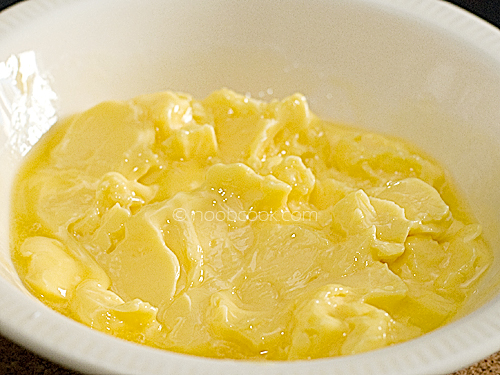How to Melt/Soften Butter in the Microwave Oven


Various stages of melting butter using the microwave oven
Melting butter via the microwave oven is a very quick process (usually less than 30 seconds) since butter had a melting point ranging from 32–35°C. I experimented with melting butter using the microwave oven because whenever a recipe calls for “butter melted at room temperature”, I was really impatient to wait for the butter to melt nicely (even though Singapore is hot all year round, the heat failed to redeem itself when it could – I find that it took at least 30-45 minutes to melt butter taken out from the fridge to room temperature).
You can melt butter to various degrees depending on the recipe you are using. Each change in state is a mere difference of 5-10 seconds of microwaving, hence it is essential to microwave them in short intervals.
1) In the first photo above, the butter though melted, is still quite “solid”. I use butter which is melted to this state when a recipe calls for “butter softened at room temperature”.
2) In the center photo above, the butter has melted completely – its texture is more watery though it is still creamy and relatively chunky. I use butter which is melted to this state when a recipe calls for “butter softened at room temperature” or “butter that is melted using gentle or indirect heat (such as a water bath/double boiler)”.
3) In the rightmost photo above, the butter has been heated for too long in the microwave oven, resulting in a greasy and watery consistency as well as some white specks of residue. It may not be suitable for all types of bakies – at least in my limited baking experience, my muffins ended up greasier and flatter.
If this is your first time melting butter via the microwave method, here are some tips:
– If your microwave oven comes with a control for the heat (low, medium, high), always go for the lowest setting.
– Butter has a very low melting point. Every short block of microwaving (5-10 seconds interval) makes a difference to the consistency of the melted butter.
– With each heating interval, you have to stir the butter with a spoon or plastic spatula to check out the actual extent to which the butter has melted (it’s not obvious based on appearances alone because butter gets heated inside-out, and retains its shape when heated), and to allow for more even microwaving. Stirring is essential!
Here’s a step-by-step guide on how I melt butter using my microwave oven.

^ Step 1: Cut butter to small cubes and place in a microwave-safe bowl. Microwave on low for about 15-20 seconds. With butter, it melts very quickly so use very short intervals of heating. Check the progress regularly; you can always put it back to the microwave oven for a few seconds longer if it’s not sufficiently melted. If you’re greedy and microwave it for a longer time, you risk overheating the butter which will result in a greasy, watery liquid which may not usable for most baking recipes.

^ Step 2: What my bowl of butter looks like after 20 seconds in the microwave oven. It doesn’t look very melted or very different from the first photo, but if you observe the leftmost corner of the bowl, you can see some melted butter at the bottom.

^ Step 3: If you stir it around with a spoon or spatula, you will realise that the butter has in fact melted substantially! Remove the spoon (no silverware inside microwave oven) and return the bowl to the microwave oven. From here on, you need to microwave the butter in shorter intervals of say 5-10 seconds.

^ Step 4: I return the bowl of butter to the microwave oven for another 5-10 seconds. This is what the butter looks like when I take it out.
^ Step 5: I stir the butter with a spoon and I found that it has melted more that it appears to be. The texture resembles butter melted at room temperature – the butter though melted, is still quite “solid”. I use butter which is melted to this state when a recipe calls for “butter melted at room temperature”, such as for my strawberry muffins and cranberry muffins.
^ Step 6: If I microwave the butter for another 5-10 seconds (remember to stir after microwaving), I get butter that has melted completely – its texture is more watery though it is still creamy and relatively chunky (reminds me of cream of chicken soup). I use butter which is melted to this state when a recipe calls for “butter that is melted using gentle or indirect heat (such as a water bath/double boiler)”, as I did for my chocolate lava cake.

^ If you were to over-melt it by microwaving it for too long, it will result in a greasy and watery consistency. It may not be suitable for all types of bakes (my muffins ended up greasy and flat). In case you’re wondering, no I did not make this failed melted butter on purpose to show you what it looks like – it was one of my (countless) kitchen disasters whereby I over-microwaved the butter, and I decided to take a photo for educational purposes (at least the butter becomes use-able in some way) :P I think you can use this butter for cooking, but it may not as perfect as it should be for baking.
Related article:
– How to Melt Chocolate Using a Microwave Oven (Step by Step Photos)
















Hello!
I stumbled upon your blog and started looking through all of your recipes!
Focusing more on what I like n bookmarking them for future references.
Thanks for making your recipes more noob-friendly n even teaching ppl how to melt butter!
I nv knew that the last type of melted butter is a screw up! Really appreciate your effort!
Thank you so much! :)
FYI: Butter has a high melting point, not a low melting point. If it had a low melting point (like water ice), then it would require a LOT more heating to warm it up to enough to melt it.
Hi Jess, if something has a low melting point, it would require LESS (not more) heating to warm it up (not to confuse melting point with boiling point). By a low melting point, what I meant was that since butter had a melting point ranging from 32–35°C, it is very easy to melt it with heat (either a stove or microwave oven). So this article is talking about the process where we want to be very careful to achieve the kind of melted butter consistency (just softened or a puddle of liquid, especially the former) which is required in recipes. Thanks for your feedback. I will re-word the article slightly.
Pingback: Quick and Easy: How To Melt Nutella In 4 Easy Ways – Big Evaluate